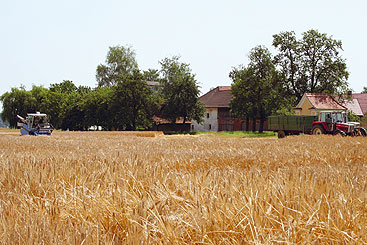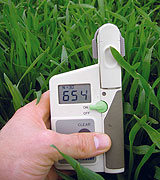
Fighting nutrient pollution with precision farming
A new device allows farmers to increase crop yields by providing the exact amount of fertiliser needed, while limiting the amount of nutrients that end up in rivers and water systems.

The N-Tester is a hand-held device which measures a plant’s chlorophyll content, a key indicator of nitrogen. For this, 30 leaves are chosen from across a field, and within a few minutes the N-Tester provides a precise measure of the crop’s exact fertiliser needs.
Making the most of limited agricultural land is essential to meet the needs of a growing world population. One method for optimising crop production in a sustainable way is ‘precision farming’ based on providing crops with exactly the right amount of fertiliser needed. This enables farmers to increase crop size and quality while preventing the run-off of excess nutrients.
The amount of nitrogen necessary for an optimal grain harvest changes from year to year and varies according to field and grain type. The N-Tester gives farmers precise information about the nutrient uptake condition of plants making it possible to determine the optimum amount of fertiliser needed at a specific time.
The N-Tester is a hand-held device which measures a plant’s chlorophyll content, a key indicator of nitrogen. For this, 30 of the youngest, most fully developed leaves are chosen from across a field, and within a few minutes the N-Tester provides a precise measure of the crop’s exact fertiliser needs.

Equipping farmers with the right tools. A project to evaluate the N-Tester was initiated in 2002 by Borealis Agrolinz Melamine, the agricultural branch of Borealis, a partner of the Business Friends of the ICPDR. The project, beginning with 40 Austrian farmers, was carried out in cooperation with Yara, RWA Raiffeisen Ware Austria AG and the Austrian Agency for Heath and Food Safety. “From this small beginning, approximately 130 farmers are now actively using the N-Tester device,” says Wolfgang Hofmair, Marketing Manager for Borealis Agrolinz Melamine. “This is of course still a small number when set against the 70,000 full-time farmers in Austria. Cost of the device may have been part of the reason for this slow takeup but this is changing as some farmers are joining together to share an N-Tester.”
One possible solution proposed is for agricultural authorities, such as the Austrian Chamber of Agriculture, to buy the N-Tester and allow farmers to borrow the device. The N-Tester has been calibrated for certain types of wheat in Austria as part of the evaluation programme, and the tool is planned to be introduced in Hungary, Romania and Serbia.
“Borealis Agrolinz Melamine always seeks to work closely with farmers to improve the practice of fertilisation,” says Hofmair. “Our commitment is to maximising farmers’ yields and the quality of their crop while protecting the environment. That is the driver which ensures the sustainable success of our business.”
Disclaimer
The information contained in the ICPDR website is intended to enhance public access to information about the ICPDR and the Danube River. The information is correct to the best of the knowledge of the ICPDR Secretariat. If errors are brought to our attention we will try to correct them.
The ICPDR, expert group members, nor other parties involved in preparation of information contained on this website cannot, however, be held responsible for the correctness and validity of the data and information provided, nor accept responsibility or liability for damages or losses arising directly or indirectly from the use of the information conveyed therein.
Only those documents clearly marked ICPDR documents reflect the position of the ICPDR.
Any links to other websites are provided for your convenience only. The ICPDR does not accept any responsibility for the accuracy, availability, or appropriateness to the user's purposes, of any information or services on any other website.
When using the information and material provided on this website, credit should be given to the ICPDR.
